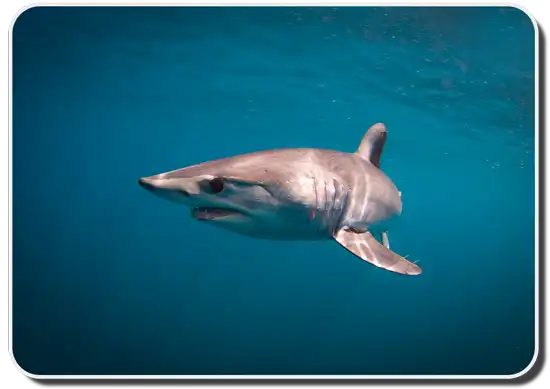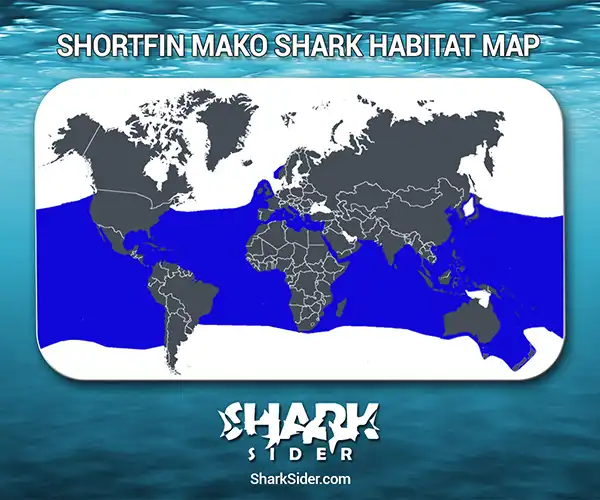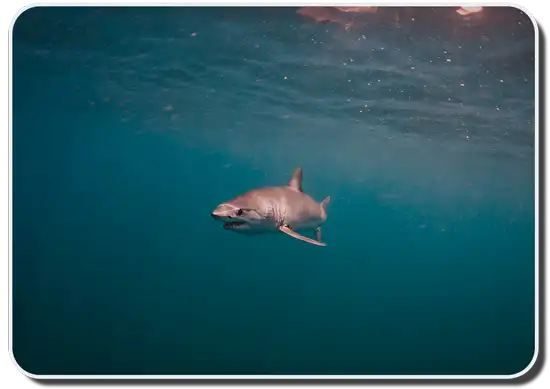The Shortfin Mako Shark is without a doubt one of the most intriguing and beautiful sharks in existence. These creatures are well known for a number of reasons, one of which being their unique appearance.

Physical Attributes
The prominent coloration of Shortfin Mako Sharks is one characteristic that sets them apart from most. The dorsal (top) side of these sharks can range from deep purples, to bright indigo blues. Their sides are typically silver, and their ventral (bottom) sides are white in color. The areas under the snout and around the mouth of Shortfin Mako sharks are also white. In addition to the distinctive colors of these sharks, their slender, elongated, and unbelievably sharp teeth are a perfect way to set them apart from many other sharks. In fact these teeth are so intense, that they stick out even when the shark’s mouth is closed!
Fins
Since the term “fin” is actually part of the Shortfin Mako Shark’s name, there must be something particularly unique about their fins. Well to be honest, their name gives it away. These Mako Sharks do have very short fins, and the second dorsal fin is considerably shorter than the first. Other physical attributes of these sharks include five large gill slits, and eyes that are extremely well developed. Like their cousin the great white, and unlike most other sharks, Shortfin Makos have endothermic circulatory systems. This means that the sharks are warm blooded, thus keeping their body temperatures considerably warmer than the water around them.
Size
When it comes to the size of these sharks, they are relatively large. They grow on average to a length of 13 feet (4 m). Shortfin Mako Sharks are members of the Lamnidae family, and interestingly enough, they grow at a rate that is two times faster than some of the other species in that family. The male Shortfin Makos typically reach maturity once they are approximately 7 feet (2 m) in length, and the females are mature at about 8.5 feet (2.6 m) in length.
Hunting and Eating Behavior
These are apex predators. If you are unfamiliar with this term, it just means that they are top predators that do not have any predators of their own within their ecosystem. In other words, Shortfin Mako Sharks feed on animals without having to constantly look over their shoulder (figuratively speaking of course) for an animal planning to eat them. If it were not for the fact that humans like to eat these sharks, they wouldn’t have any predators whatsoever.
Main Food Source
Now what exactly does an apex predator of this sort eat? Well, Shortfin Makos enjoy dining on exceptionally fast-swimming fish such as highly developed tuna and billfish. That’s not all. These sharks enjoy the tastes of Blue Sharks, dolphins, squids, mackerels, porpoises, and sea turtles. They most definitely have diverse food preferences.
The Fastest Shark in the Ocean
No shark can swim quite like the Shortfin Mako Shark. They are one of the fastest sharks in the ocean! The speeds and distances in which these Makos can swim are unbelievable. Shortfin Makos have been estimated to swim at constant speeds of 21.75 mph (35 kph) with bursts of more than 49.71 mph (80 kph)! Due to the exceedingly fast rates in which these sharks can swim, it isn’t hard to believe that they tend to travel far in an extremely short amount of time. They have been known to venture as far as 1,299 miles (2,092 km) in a little over a month!
The Shortfin Mako Shark’s Amazing Speed
Shortfin Mako Shark Habitat
Map Of The Shortfin Mako Shark’s Habitat

Now one may think that Shortfin Makos spend the majority of their time in the depths of the ocean. While it is true that these sharks enjoy swimming in very deep waters much of the time, they can also be found at the water’s surface just as often. If they’re not in the mood to swim at the water’s surface, they have the ability to dive more than 400 feet (122 m) into the depths of the ocean. In addition to the Mako Shark’s remarkable swimming and diving talents, they are also known for being spectacular leapers. That’s right; a Shortfin Mako can jump as high as 20 feet (6 m) out of the water! They are living proof that some don’t have to own legs in order to jump high.
Mako Sharks can be anywhere in the world they choose to be. Excluding exceptionally cold waters, these sharks have been spotted all over the globe. Due to the fact that Shortfin Mako Sharks have the ability to travel at rapid speeds and they prefer warmer waters, they are often found in the Pacific Ocean. They have been seen everywhere from the United States to Chile.
Shortfin Mako Sharks do have a special preference for the waters surrounding Southern California, specifically San Diego. Oftentimes, however, the Makos found in this area during the summer months are adolescent sharks. Because of the amount of young sharks found in this area, it is believed by some scientists that the female Makos migrate to these waters when it is time for them to have pups. Newborns, and very young Shortfin Makos around the ages of 1 and 2 can often be found in and near the San Diego waters during the months of Spring, Summer, and Autumn.
Reproduction And Offspring
Female Shortfin Mako Sharks conduct reproduction in an Ovoviviparous nature after they have reached a length of at least 9 feet (3 m). During this method, the shark’s eggs are kept in the same brood chamber in which the embryo develops; the embryo is able to receive sustenance from a yolk sac. Unlike many animals that are not mammals, these sharks are “live-bearing” fish. This means that the mother gives birth to pups after they have hatched from egg capsules while still inside her uterus. This particular process is also known as aplacental Viviparous.
Duration of Pregnancy
While it is very true that Shortfin Mako Sharks can swim faster than a human on any given day, they take a lot longer to complete their gestation (pregnancy) periods. These sharks can be pregnant from 15-18 months!
Cannibalism in Pups
Not only do the developing embryos feed on unfertilized eggs within the uterus during this time, but they also participate in ovophagy. During the process of ovophagy, the developing pups actually feed on the lesser-developed fetuses; this can be described as intra-uteral cannibalism. This astonishing method is the norm for a few species other than the Shortfin Mako Shark, however it is not common.
Timing and Size of Pups
During the late winter and early spring, the mother shark gives birth to the pups that have survived the ovophagy process. It is possible for her to deliver 4-18 pups, however litters of or less than 8-10 pups are more common. These baby sharks are approximately 28 inches (70 cm) in length. Many believe that the mother Mako has an 18-month period of rest after giving birth; once this period is over, she can have another group of eggs fertilized.
 Mystery Remains
Mystery Remains
While it may seem that we have completely covered this process, in truth, there are many aspects of Shortfin Mako Shark reproduction that we are completely unaware of. This is due to the fact that when pregnant Makos are captured, they purposefully abort their embryos.
Human Interaction
There have been reports of Shortfin Mako Sharks attacking humans; however, it is very rare for one of these sharks to attack without human provocation. Due to the sheer size and power of these fish, some of these attacks have been fatal, but Makos are sincerely not interested in feeding on humans. When a human has been hurt by one of these sharks, it is oftentimes after a shark has been captured on the end of a fishing line. They have been known to injure fishermen and damage boats, but let’s be honest: what would you do if someone hooked you?
Humans have been known to unjustly blame Shortfin Makos for the depletion of other popularly fished animals such as tuna and mackerel. In truth, these sharks are frequent victims of both commercial and recreational fishing themselves. The human desire for shark fin soup alone has caused the Shortfin Mako Shark population to decrease exponentially. The Makos have suffered over harvesting, and they often become casualties by companies who harvest swordfish and tuna.
Conservation Efforts
Due to the rapidly depleting population of Shortfin Mako Sharks caused by commercial, recreational, and “accidental” fishing, the United States National Marine Fisheries Service (NMFS) has put regulations in place in the efforts of conserving these wonderful animals. The NMFS ordered a 50% reduction in allowed Shortfin Mako catches per year. Unfortunately, however, this and other NMFS regulations only apply to the United States’ Gulf and Atlantic waters. It is wonderful that there are those who have taken it upon themselves to help the Shortfin Mako Sharks. We can only hope that more people around the world will follow suit, and do their part to protect the Shortfin Mako Sharks.
